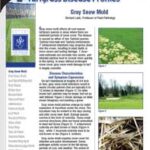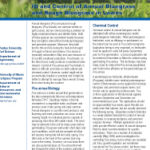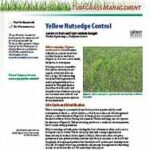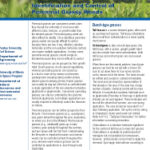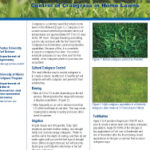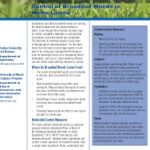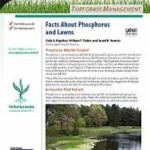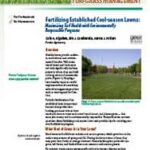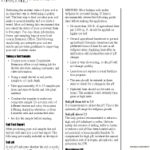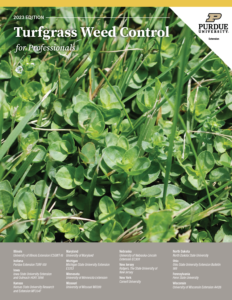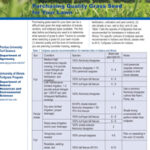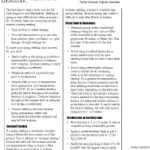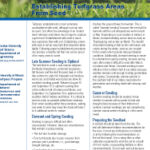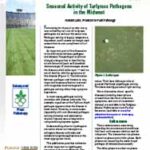Extension Publications
Turfgrass Disease Profiles: Brown Patch (BP-106-W)
Purdue Extension Publication
Brown patch is caused by a fungal pathogen that affects all cool-season turfgrass species. Moderate to severe outbreaks on high-maintenance creeping bentgrass and annual bluegrass can result in thin, poor quality turf that may be predisposed to algae and moss infestation. This publication describes the symptoms and development of this disease, and provides management options.
Turfgrass Disease Profiles: Dollar Spot (BP-105-W)
Purdue Extension Publication
Dollar spot is caused by a fungal pathogen and is a common concern on golf course turf, especially creeping bentgrass and annual bluegrass greens, tees, and fairways, where it can result in poor turf quality and appearance. This publication describes the symptoms and development of this disease, and provides management options.
Turfgrass Disease Profiles: Red Thread (BP-104-W)
Purdue Extension Publication
Turfgrass Disease Profiles: Leaf Spot/Melting Out (BP-103-W)
Purdue Extension Publication
Leaf spot and melting out are different diseases with similar symptoms and pathogen characteristics. They both attack Kentucky bluegrass, perennial ryegrass, and tall fescue, and appear to cause the most damage to golf course roughs, sports turf, and residential lawns. This publication describes the symptoms and development of this disease, and provides management options.
Turfgrass Disease Profiles: Gray Snow Mold (BP-101-W)
Purdue Extension Publication
Gray snow mold affects all cool season turfgrass species in areas where there are extended periods of snow cover. This publication discusses how to identify gray snow mold, and examines options for controlling the disease.
ID and Control of Annual Bluegrass and Rough Bluegrass in Lawns (AY-41-W)
Purdue Extension Publication
Controlling annual bluegrass (Poa annua) and rough bluegrass (Poa trivialis) in lawns is difficult, and relies on both cultural and chemical control. This publication describes these weeds and offers management strategies.
Yellow Nutsedge Control (AY-19-W)
Purdue Extension Publication
This publication describes the life cycle and identification of yellow nutsedge and recommends cultural and chemical management options for homeowners. A similar publication is available for turf professionals: Turfgrass Management Sedge Control for Turf Professionals (AY-338-W)
Facts About Phosphorus and Lawns (AY-334-W)
Purdue Extension Publication
This publication for both professionals and homeowners examines the role that phosphorus plays in turfgrass growth, explains how to determine the needs of specific turf stands, and provides suggestions for proper application to reduce the risk of contaminating surface waters.
Fertilizing Established Lawns (AY-22-W)
Purdue Extension Publication
Fertilizing established lawns keeps the lawn looking good and reduces how much you have to water and control weed, insect, and disease pests — that saves you money and is environmentally responsible. This publication answers questions about fertilizing cool-season lawns and provides tips for creating your own fertilization program.
Turfgrass Weed Control for Professionals (TURF-100)
Purdue Extension Publication
This guide provides weed identification and control information that turfgrass professionals can use to develop effective weed control programs for golf courses, athletic fields, sod farms, lawns, and other turfgrass systems. The recommendations apply to the majority of the United States, with input from experts in Illinois, Indiana, Iowa, Kansas, Kentucky, Maryland, Michigan, Minnesota, Missouri, […]
Purchasing Quality Grass Seed for Your Lawn (AY-25-W)
Purdue Extension Publication
This publication provides help when selecting turfgrass for different lawns. Things to look for on a bag of quality grass seed are also covered. It also defines key terms that are used with planting and maintaining turfgrasses.
Seeding a Turf Area in the Spring (AY-20-W)
Purdue Extension Publication
This publication provides turf seeding guidelines in the spring for established turf areas and new turf areas.
Turfgrass Insects: Managing White Grubs in Turfgrass (E-271-W)
Purdue Extension Publication
This publication provides Indiana turfgrass management professionals and property owners with information to help them (1) properly identify the most common white grub species, (2) understand white grub biology, (3) recognize white grub damage, and (4) formulate safe and effective management strategies.
Turfgrass Disease Profiles: Seasonal Activity of Turfgrass Pathogens (BP-125-W)
Purdue Extension Publication
Understanding when turf pathogens are active allows turf managers to anticipate disease outbreaks and schedule fungicide applications at the most appropriate times. This publication provides estimates of when important turf pathogens are active in the lower Midwest.
